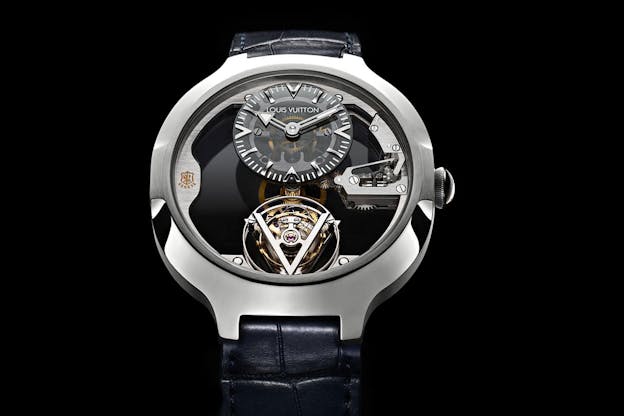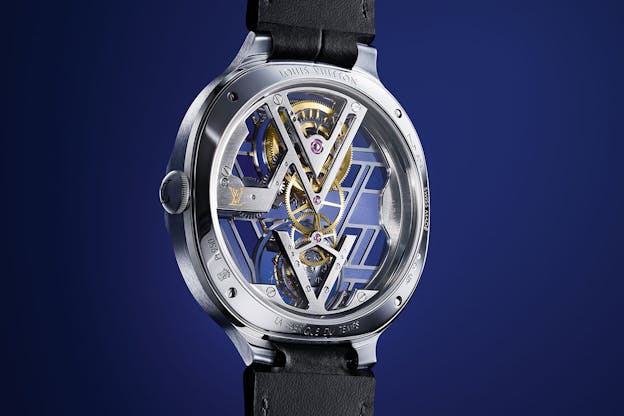Introducing The Louis Vuitton Voyager Flying Tourbillon ‘Poinçon De Genève’ Plique-À-Jour
The stained glass window of enameling techniques turns this tourbillon into a horological cathedral.
Enameling, depending on what kind of enameling you are talking about, and what period in the history of watchmaking you are talking about, can be anything from ubiquitous to vanishingly rare. Fired enamel dials were used on millions of pocket watches during the 19th century, for instance; enamel miniature painting, however, is a highly demanding manual craft which requires both talent and years of practice and even today, there are probably only a handful of artists in the world who can do it.
Enameling, once you get away from the creation of basic, monochromatic fired enamel dials, has a great variety of techniques from which an almost infinite number of designs can be created. Techniques like cloisonné, champlevé, and pailloné are just a few of the methods available to an enamelist and each presents its own characteristic opportunities and challenges.
One of the most challenging techniques is plique-à-jour. While most enameling has a solid metal base over which the enamel is applied – sometimes separated by wire, as in cloisonné, or deposited in individual cells, as in cloisonné – there is no backing in the final product in plique-à-jour. Instead, enamel is applied to a design with a temporary backing, traditionally made of mica (to which enamel won’t stick) or metal, which is dissolved by an acid after the enamel is fired. The result is essentially a miniature stained glass window and in fact the name means, approximately, “to let in the daylight.” This is the technique which Louis Vuitton has used for the Voyager Flying Tourbillon Poinćon de Genève Plique-À-Jour.

The Voyager case design is a relatively new one in Louis Vuitton’s lineup – it was originally introduced in 2016, when the Voyager Flying Tourbillon Poinçon de Genève was launched. That watch represented a quite radical take on an openworked tourbillon watch – the flying tourbillon and its cage were almost the same diameter as the slightly larger, smoked semi-transparent dial for the hour and minute hands, with the going train running right down the vertical axis of the watch (the mainspring barrel is hidden under the subdial for the time) and the only visible connection between the movement and the outside world are the keyless works for winding and setting, adjacent to the crown.
The Voyager case has also been used in the Voyager Minute Repeater Flying Tourbillon.

The Voyager case is described by Louis Vuitton as being halfway between a circle and a square, but the case shape is more complex than that, with deep concavities wrapping around the top and bottom of the case, interrupted by brush finished sections at the crown, and directly opposite the crown at 9:00

The original Voyager Flying Tourbillon Poinçon de Genève is one of the most transparent openworked movements I’ve ever seen and the amount of available space plus the amount of light that can pass through the watch, makes it a perfect place to use plique-à-jour enameling.

Plique-à-jour enameling originated in the Byzantine empire in the fourth and fifth centuries BC and was known in the Renaissance – Benvenuto Cellini, perhaps the most famous Renaissance goldsmith, describes the technique in a treatise from 1568 – but the technique was more or less lost until the late 19th century when it was gradually revived, notably by Fabergé. Plique-à-jour is fragile – few examples have survived intact from before the 19th century.
There are several different ways of creating plique-à-jour enamel works and the particular technique chosen by Louis Vuitton for the Voyager Flying Tourbillon Poinçon de Genève Plique-à-Jour is known as “percé,” or pierced, plique-à-jour, as the enamel is applied to cells cut into a pierced metal frame.

Fired enamel dials of any kind carry some risk of failure during the firing process, and thanks to the technical challenges associated with plique-à-jour, the chances of a mishap causing rejection of a work in progress is even higher than usual. In the 1998 Dictionary Of Enameling, by Erica Speel, the author notes, “Plique-a-jour has been in fashion since the late 19th century for jewelry and small decorative articles. Although visually very alluring, plique-a-jour pieces are more fragile than other types of enamel work and require careful handling in use. Making these pieces is more time-consuming than other enamel work and there is a potentially higher failure rate.”
The cells of the dial are in white gold, and arranged in a V motif, for Vuitton, but the effect is subtle and the design works purely as a decorative geometric motif, as well as an evocation of the history and legacy of the company. There are up to six different layers of enamel in each cell on the dial, with a corresponding number of firings, and Louis Vuitton says that it takes about 100 hours in all to craft each dial. In recent years Louis Vuitton has been increasing the volume and sophistication of enamelwork in its watches and its capacity to produce those dials at La Fabrique du Temps in Geneva – which is where the dials for the Voyager Flying Tourbillon Poinçon de Genève Plique-a-Jour are made.

One of the many interesting challenges involved in making the dial is the placement of the pipe for the hour and minute hand pinions – it has to be perfectly centered and the enamelist is responsible for ensuring that the pipe is exactly concentric with the pinions.
The Poinçon de Genève
The Poinçon de Genève, or Geneva Seal, is a quality hallmark given to watches made in the city and canton of Geneva, which fulfill certain requirements. It was originally introduced in 1886 and for decades, inspection was carried out by the Geneva School Of Watchmaking. Currently, the Seal is administered by the Timelab Foundation in Geneva, and the criteria for the Seal are still quite strict, covering a number of minute features of movement finishing, as well as various functional criteria.

The Geneva Seal is not used as widely today as it was before the 2000s, but it still represents one of the few third party standard of criteria and inspection procedures. Other such such standards include the COSC, and chronometer certifications at the Geneva Observatory, as well as the observatory at Besançon in France.

Caliber LV104 is a hand-wound, one minute flying tourbillon, with an 80 hour power reserve.

Geneva Seal movements do have to adhere to specific criteria in terms of craftsmanship and quality (and of course, they have to be made in Geneva) but within those constraints watchmakers and movement constructors are free to explore an enormous variety of design options. The caliber LV104 is certainly not a movement designed in the classic, full-bridge Swiss style, but it is a technically interesting and visually striking caliber, and its adherence to the Geneva Seal standards means, from an aesthetic standpoint, a number of beautifully polished metal surfaces which add luster and light to enamel work.
The name of the watch – Louis Vuitton Voyager Flying Tourbillon Poinçon De Genève Plique-À-Jour – is a mouthful but like the watch itself, it brings together a number of different aspects of fine watchmaking and I think, is a great demonstration of why and how watches are potentially such fascinating objects. Here we have a watch which is interesting and innovative from a technical standpoint, and which also connects to both the history of watchmaking at Louis Vuitton, and the history of watchmaking in Geneva – as well as of course to the history of the decorative arts as well.
The Louis Vuitton Voyager Flying Tourbillon Poinçon de Genève Plique-a-Jour: Case, platinum and 18k white gold, 41mm x 11.68mm, sapphire front and back with AR coating; water resistance, 50M. Dial, handmade plique-à-jour enamel. Movement, caliber LV104, hand-wound, developed and assembled at La Fabrique du Temps; one minute flying tourbillon with V-shaped cage running at 21,600 vph in 17 jewels. Poinçon de Genève certification. Price, $310,000. For more on Louis Vuitton watchmaking, visit LouisVuitton.com.

